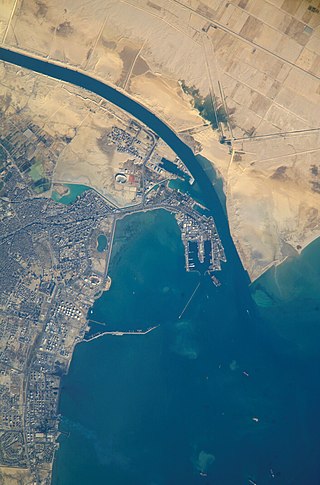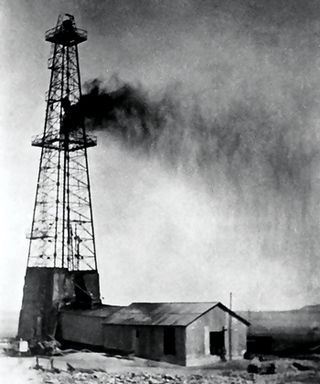
The Persian Gulf, sometimes called the Arabian Gulf, is a mediterranean sea in Western Asia. The body of water is an extension of the Indian Ocean located between Iran and the Arabian Peninsula. It is connected to the Gulf of Oman in the east by the Strait of Hormuz. The Shatt al-Arab river delta forms the northwest shoreline.

The Red Sea is a seawater inlet of the Indian Ocean, lying between Africa and Asia. Its connection to the ocean is in the south, through the Bab el Mandeb strait and the Gulf of Aden. To its north lie the Sinai Peninsula, the Gulf of Aqaba, and the Gulf of Suez. It is underlain by the Red Sea Rift, which is part of the Great Rift Valley.

The Suez Canal is an artificial sea-level waterway in Egypt, connecting the Mediterranean Sea to the Red Sea through the Isthmus of Suez and dividing Africa and Asia. The 193.30 km (120.11 mi) long canal is a popular trade route between Europe and Asia.

The Bab-el-Mandeb, or the Gate of Grief, is a strait between Yemen on the Arabian Peninsula, and Djibouti and Eritrea in the Horn of Africa. It connects the Red Sea to the Gulf of Aden.

Suez is a seaport city in north-eastern Egypt, located on the north coast of the Gulf of Suez on the Red Sea, near the southern terminus of the Suez Canal, and is the capital of the Suez Governorate. It has three ports: the Suez Port, al-Adabiya, and al-Zaytiya, and extensive port facilities. Together they form a metropolitan area, located mostly in Africa with a small portion in Asia.

The 1973 oil crisis or first oil crisis began in October 1973 when the members of the Organization of Arab Petroleum Exporting Countries (OAPEC), led by King Faisal of Saudi Arabia, proclaimed an oil embargo. The embargo was targeted at nations that had supported Israel during the Yom Kippur War. The initial nations targeted were Canada, Japan, the Netherlands, the United Kingdom and the United States, though the embargo also later extended to Portugal, Rhodesia and South Africa. By the end of the embargo in March 1974, the price of oil had risen nearly 300%, from US$3 per barrel ($19/m3) to nearly $12 per barrel ($75/m3) globally; US prices were significantly higher. The embargo caused an oil crisis, or "shock", with many short- and long-term effects on global politics and the global economy. It was later called the "first oil shock", followed by the 1979 oil crisis, termed the "second oil shock".

The Straits of Tiran are the narrow sea passages between the Sinai and Arabian peninsulas that connect the Gulf of Aqaba and the Red Sea. The distance between the two peninsulas is about 13 km. The Multinational Force and Observers monitors the compliance of Egypt in maintaining freedom of navigation of the straits, as provided under the Egypt–Israel peace treaty.

Western Asia, also called West Asia or Southwest Asia, is the westernmost region of Asia, as defined by some academics, UN bodies and other institutions, and includes Anatolia, the Arabian Peninsula, Iran, Mesopotamia, the Armenian Highlands, the Levant, the island of Cyprus, the Sinai Peninsula, and partly the Caucasus Region (Transcaucasia). The region is considered to be separated from Africa by the Isthmus of Suez in Egypt, and separated from Europe by the waterways of the Turkish Straits and the watershed of the Greater Caucasus. Central Asia lies to its northeast, while South Asia lies to its east. Twelve seas surround the region (clockwise): the Aegean Sea, the Sea of Marmara, the Black Sea, the Caspian Sea, the Persian Gulf, the Gulf of Oman, the Arabian Sea, the Gulf of Aden, the Red Sea, the Gulf of Aqaba, the Gulf of Suez, and the Mediterranean Sea. The area contains the vast majority of the similarly defined Middle East, except excluding the African part of Egypt, and including the southern part of the Caucasus.

The Trans-Israel pipeline, also Tipline, Eilat–Ashkelon Pipeline, or Europe–Asia Pipeline is an oil pipeline in Israel extending from the Gulf of Aqaba on the Red Sea to the Mediterranean Sea. It was originally built to transport crude oil originating from Iran inside Israel and to Europe.

In military strategy, a choke point is a geographical feature on land such as a valley, defile or bridge, or maritime passage through a critical waterway such as a strait, which an armed force is forced to pass through in order to reach its objective, sometimes on a substantially narrowed front and therefore greatly decreasing its combat effectiveness by making it harder to bring superior numbers to bear. A choke point can allow a numerically inferior defending force to use the terrain as a force multiplier to thwart or ambush a much larger opponent, as the attacker cannot advance any further without first securing passage through the choke point.

The Trans-Arabian Pipeline (Tapline), was an oil pipeline from Qaisumah in Saudi Arabia to Sidon in Lebanon, active between 1950–1976. In its heyday, it was an important factor in the global trade of petroleum, as well as in American–Middle Eastern political relations, while locally helping with the economic development of Lebanon.
Roger Edward Tamraz is an international banker and venture capital investor who has had an active business career in oil and gas in the Middle East, Europe, Asia and the United States since the early 1960s. He is the billionaire chairman of the Dubai, UAE-based petroleum energy firm NetOil.
For further details see the "Energy crisis" series by Facts on File.
The Dolphin Gas Project is the natural gas project of Qatar, the United Arab Emirates, and Oman. It is the Gulf Cooperation Council's first cross-border refined gas transmission project and the largest energy-related venture ever undertaken in the region.

Energy in Saudi Arabia involves petroleum and natural gas production, consumption, and exports, and electricity production. Saudi Arabia is the world's leading oil producer and exporter. Saudi Arabia's economy is petroleum-based; oil accounts for 90% of the country's exports and nearly 75% of government revenue. The oil industry produces about 45% of Saudi Arabia's gross domestic product, against 40% from the private sector. Saudi Arabia has per capita GDP of $20,700. The economy is still very dependent on oil despite diversification, in particular in the petrochemical sector.

Habshan–Fujairah oil pipeline, also known as "Abu Dhabi Crude Oil Pipeline (ADCOP)", is an oil pipeline in the United Arab Emirates. It starts from the Habshan onshore field in Abu Dhabi and runs to Fujairah on the Gulf of Oman.
The Arab Cold War was a period of political rivalry in the Arab world from the early 1950s to the late 1970s as part of the broader Cold War. The generally accepted beginning of the Arab Cold War was the Egyptian revolution of 1952, which ultimately led to Gamal Abdel Nasser becoming President of Egypt in 1956. Thereafter, newly established Arab republics defined by revolutionary secular nationalism, and largely drawing inspiration from Nasser's Egypt, were engaged in political rivalries of varying degrees of ferocity with conservative traditionalist Arab monarchies, led chiefly by Saudi Arabia. The approximate end point of this period of internecine rivalry and conflict is generally viewed as being the 1979 Iranian Revolution, which culminated in the installation of Ayatollah Ruhollah Khomeini as the leader of Iran's theocratic government. Thereafter, the bitterness of intra-Arab strife was eclipsed by a new era of Arab-Iranian tensions.

Saudi Arabian oil was first discovered by the Americans in commercial quantities at Dammam oil well No. 7 in 1938 in what is now modern day Dhahran.

The Bahrain Petroleum Company (BAPCO) is an integrated national oil company of Bahrain.















